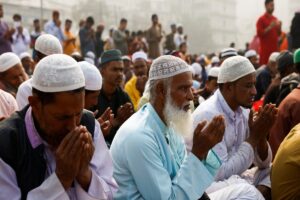Medics working in the Gaza Strip are using a specific phrase to describe a particular kind of war victim.
“There’s an acronym that’s unique to the Gaza Strip, it’s WCNSF – wounded child, no surviving family – and it’s not used infrequently,” Dr Tanya Haj-Hassan who works with Doctors Without Borders told BBC News.
The expression captures the horror of the situation for many Gazan children. Their lives change in a second – their parents, siblings and grandparents are killed, and nothing is the same ever again.
The war began after Hamas attacked Israel on 7 October killing 1,200 people and taking around 240 others hostage, and Israel launched its military campaign. More than 15,500 people have been killed in the conflict, including about 6,000 children, according to Gaza’s Hamas-run health ministry.
Ahmed Shabat is one of those children who was described as a wounded child, with no surviving family, when he arrived injured and crying at the Indonesian Hospital in northern Gaza. The three-year-old survived an air strike on his home in Beit Hanoun, in mid-November. But his father, mother and older brother were killed.
Miraculously, at the time he had only minor injuries. Later it was revealed his younger brother Omar, aged two, had also survived the strike and they were reunited after an adult member of the wider family was located.
“After the bombing, we learned there was a child in the Indonesian hospital with no-one accompanying him, so we went there immediately,” Ahmed’s uncle Ibrahim Abu Amsha explained. “Ahmed was with a stranger. He said Ahmed had been blown into the air and was found injured about 20m (65ft) from the house.”
Ahmed and Omar were now orphans, homeless, with no shelter to protect them from continuous shelling, so Ibrahim decided to look after them, along with his own family. He initially took them to Sheikh Radwan city but said they left after “Ahmed was hit by glass fragments” from an explosion.
They then went to Nuseirat camp to stay in a UN-affiliated school. But even in their new location, they were hit again, with devastating consequences for Ahmed.
“I ran out of the school’s door and saw Ahmed in front of me on the ground, both legs gone. He was crawling towards me, opening his arms, seeking help.” A family member, who was with Ahmed at the time of the blast, was killed.
Ibrahim, who is still displaced with his own family as well as his sister’s children, says he dreams of being able to send Ahmed for treatment outside Gaza.
“He wanted to be many things,” his uncle said sadly. “When we went out together to attend football matches, he said he wished to become a famous football player.”
Crying for mum
Like Ahmed, Muna Alwan is also a war orphan and was described as WCNSF when she arrived at the Indonesian Hospital.
The two-year-old constantly cries “Mama”, but her mum is dead.
Muna was pulled from under the rubble after an air strike hit a neighbour’s house in the Jabal al-Rais area of northern Gaza. Muna’s parents, brother and grandfather were killed. Muna’s eye was badly injured and her jaw fractured.
Muna was transferred to another hospital where she was tracked down by her aunt Hanaa.
“We knew through the internet that Muna was at Nasser Hospital. We came, and we recognised her,” Hanaa explains. But she says her niece is suffering terribly.
“She just wants to scream, always afraid, especially if someone approaches her,” Hanaa adds.
Muna does have older sisters who are alive but they are in Gaza City.
“They are stuck and there is no way to bring them to the south,” Hanaa says, adding: “I constantly ask myself, what will we do? How do we compensate for her mother?”
‘I lost my leg and my family’
On a metal bed in the corner of a room at Nasser Hospital in Khan Yunis, southern Gaza, 11-year-old Dunya Abu Mehsen looks at what remains of her right leg wrapped in white bandages.
The girl, with long curly hair, sits at the edge of the bed, wearing a velvety red dress, silent most of the time, appearing deeply sad.
Dunya survived an air strike with her brother, Yusuf, and her younger sister that hit when they were all sleeping at their home in the al-Amal neighbourhood in Khan Yunis, southern Gaza.
But her parents, brother and sister were killed. She also lost her right leg.
“When I saw my dad, I was scared because he was covered in blood and stones. People were standing around us, and my sister was screaming,” Dunya recounts. “I looked at myself and I didn’t have a leg. I felt pain and my only thought was: ‘How did I lose my leg?'”
“Dunya doesn’t recall how and when she arrived at the hospital, but she remembers being there alone, and the medical staff repeatedly asking her questions in an attempt to identify her family,” explains her aunt Fadwa Abu Mehsen.
“She told me: ‘I heard the nurse say, ‘may God have mercy on them’. I knew she meant my mum and dad.'”
Her aunt, sitting beside her in the hospital room with the wheelchair that has become the only means for the little girl to go outside and breathe fresh air, says: “She used to be playful, strong and very active before her injury.”
Dunya says: “Today, I lost my leg and my family but I still have dreams. I want to get a prosthetic leg, travel, become a doctor, and for this war to end and our children to live in peace.'”
Determining the precise number of orphaned children in the Gaza Strip is challenging given the “intensity of hostilities and rapidly evolving situation on the ground”, according to Ricardo Pires, the communication manager at the UN children’s fund Unicef.
Mr Pires adds that the organisation attempted to reach hospitals and health staff in Gaza to identify and register children, but “these efforts are proceeding very slowly due to the extremely challenging conditions”.
He explained not only was it “almost impossible” to identify safe, temporary care arrangements due to “chaotic and overcrowded” shelters and hospitals, but “the normal system to identify document, trace and reunite children with relatives is barely functional”.
Source : BBC









